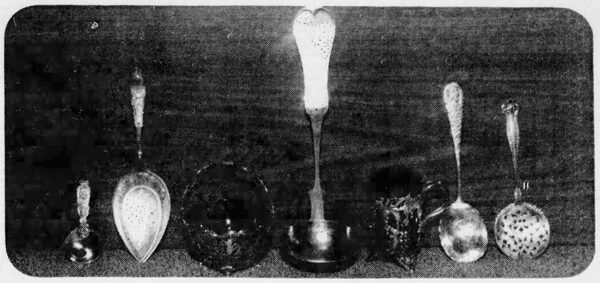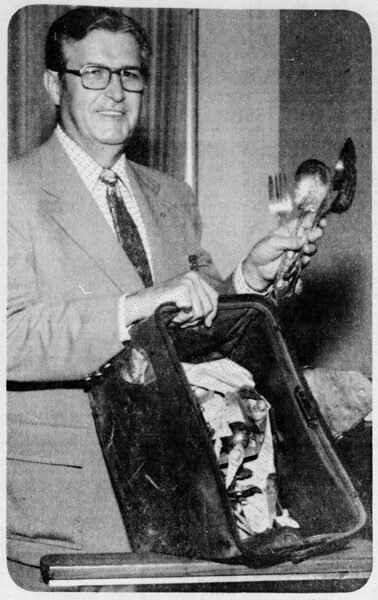[Newspaper]
Publication: The Kentucky Enquirer
Cincinnati, OH, United States
vol. 135, no. 53, p. 3, col. 1-8
Old Silver Trove Discovered in Bank
A treasury of fine silver — flatware, candy dishes, cream pitchers and other sterling items — has been uncovered at the First National Bank of Covington and officials are searching for the owner or heirs.
| |||
| Tarnished but valuable: Cache consists mostly of tableservice items |
Harry K. Lowe, First National president, tells of the collection of more than 100 pieces being found in a storage vault of the bank, packed in a leather bag.
Inside, much of the silverware was wrapped in a newspaper with a May, 1907, date.
A search of the bag revealed tucked away in a corner the name of Mr. and Mrs. Daniel Carroll Hemingray, a one-time prominent Northern Kentucky family.
THE BAG ITSELF was covered with stickers from hotels in Dublin, Ireland; Naples, Italy; Frankfurt, Germany, and other foreign cities.
How it got there or why it was never reclaimed is a mystery to bank officials.
| |||
| Lowe with well-Worn bag, tarnished silver |
A check of Covington city directories at the turn of the century revealed a D.C. Hemingray lived at 636 Greenup St. and was listed as secretary of the Hemingray Glass Co., Second and Madison.
The last directory with the Hemingray name was in 1914 with a note that he had moved to Glendale. Another Hemingray, listed as R. G. in the directory, was noted as having a residence in Muncie, Ind. He was the glass company president.
AFTER THE 1914 listing of the name of the family and the company was A C. Shinkle, company vice president. Some believe he may have been Clifford Shinkle, the grandson of Amos Shinkle, first president of First National Bank. Other reports say that Daniel Hemingray was a member of the Board of Directors of the Ohio Bridge Co., owners and operators of the Suspension Bridge, a Shinkle enterprise.
In trying to piece together the mystery of the silver, bank officials believe that it might have been left for safekeeping on one of the Hemingray’s jaunts to Europe. Or it may have been stored away when the family moved from Covington.
THE STORAGE of the silver may have come before First National acquired the building in 1910. Prior to that date, the structure was the home of the Farmers and Traders Bank which was purchased by First National.
The silver lode includes dinner knives with mother-of-pearl handles, salt cellars, silver picks for olives, serving spoons for pies, a spoon for serving nuts or small candies, ladles for punch bowls, a huge gravy spoon and other serving spoons.
Age has tarnished many of the pieces but the few which have been polished are in remarkably good condition.

